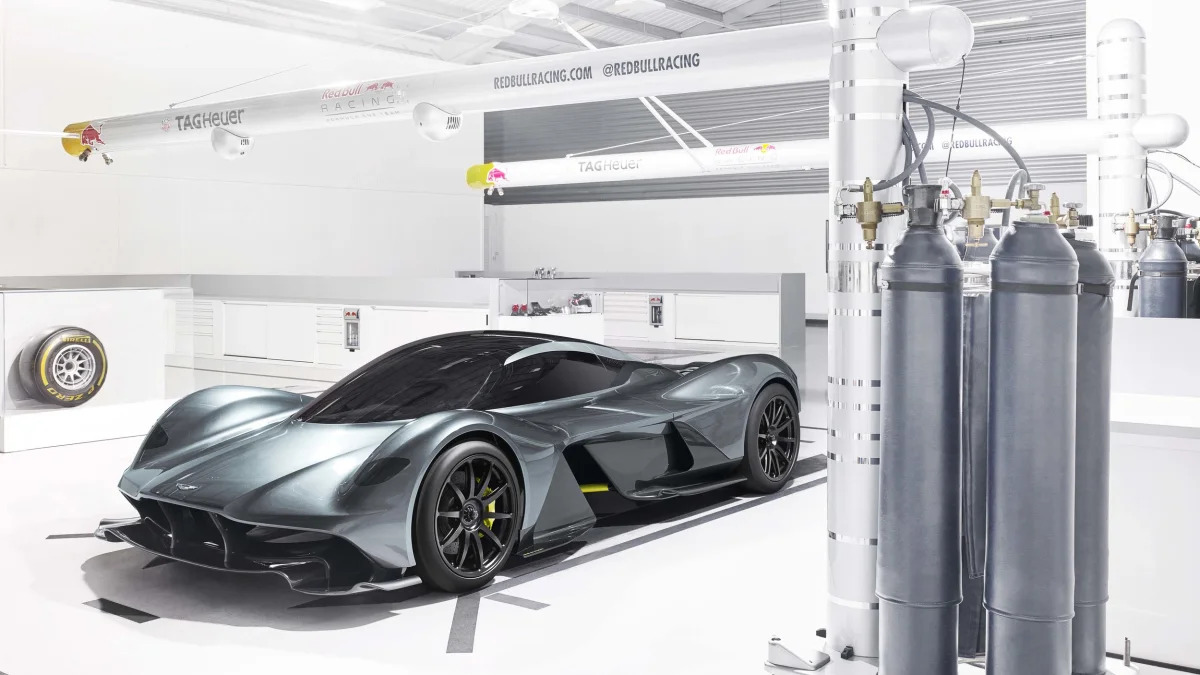The Aston Martin AM-RB 001 is starting to sound like it will be the most extreme hypercar ever made. We're basing that on a series of new comments made by Red Bull Racing's resident aerodynamic genius and chief technical officer, Adrian Newey, in an interview with The Wall Street Journal's Dan Neil.
Newey shared many interesting nuggets, so we'll try to provide a simple summary of how frighteningly potent the AM-RB 001 is. The new hypercar should hit 200 miles per hour in around 10 seconds, while a massive set of brakes will cut that speed to zero in half the time – in other words, zero to 200 to zero in just 15 seconds. That kind of stopping power sounds physically painful. Certain versions of the 001 will make up to 4,400 pounds of downforce, and if that's not enough to keep the car pasted to the pavement through 4G bends, Newey hinted that the active suspension will rely on the ground effect more than any other car.
"I studied aero at the University of Southampton," Newey told Neil. "My final-year project in 1979 and '80 was on ground-effects aerodynamics applied to road cars and sports cars."
Beyond the performance stats, Newey verified some of the broader questions about the 001's availability. For one, Aston Martin and Red Bull will build 175 examples of the potentially record-breaking hypercar, with 150 designated for road use and another 25 limited to the track – they're the ones that will enjoy the 4,400 pounds of downforce and full-on 4G cornering ability – so the chances you'll ever encounter a 001 in the wild are almost nil. And buying one? Plan on spending at least $3 million.
Newey, along with Aston Martin Chief Designer Marek Reichman and Project Engineer David King, reveal more about the 001 in the piece, including some of the philosophical and design principles behind a $3M hypercar. It's very much worth a read, if you can get around the WSJ's pay wall.
Related Video:
Newey shared many interesting nuggets, so we'll try to provide a simple summary of how frighteningly potent the AM-RB 001 is. The new hypercar should hit 200 miles per hour in around 10 seconds, while a massive set of brakes will cut that speed to zero in half the time – in other words, zero to 200 to zero in just 15 seconds. That kind of stopping power sounds physically painful. Certain versions of the 001 will make up to 4,400 pounds of downforce, and if that's not enough to keep the car pasted to the pavement through 4G bends, Newey hinted that the active suspension will rely on the ground effect more than any other car.
"I studied aero at the University of Southampton," Newey told Neil. "My final-year project in 1979 and '80 was on ground-effects aerodynamics applied to road cars and sports cars."
Beyond the performance stats, Newey verified some of the broader questions about the 001's availability. For one, Aston Martin and Red Bull will build 175 examples of the potentially record-breaking hypercar, with 150 designated for road use and another 25 limited to the track – they're the ones that will enjoy the 4,400 pounds of downforce and full-on 4G cornering ability – so the chances you'll ever encounter a 001 in the wild are almost nil. And buying one? Plan on spending at least $3 million.
Newey, along with Aston Martin Chief Designer Marek Reichman and Project Engineer David King, reveal more about the 001 in the piece, including some of the philosophical and design principles behind a $3M hypercar. It's very much worth a read, if you can get around the WSJ's pay wall.
Related Video:










Sign in to post
Please sign in to leave a comment.
Continue